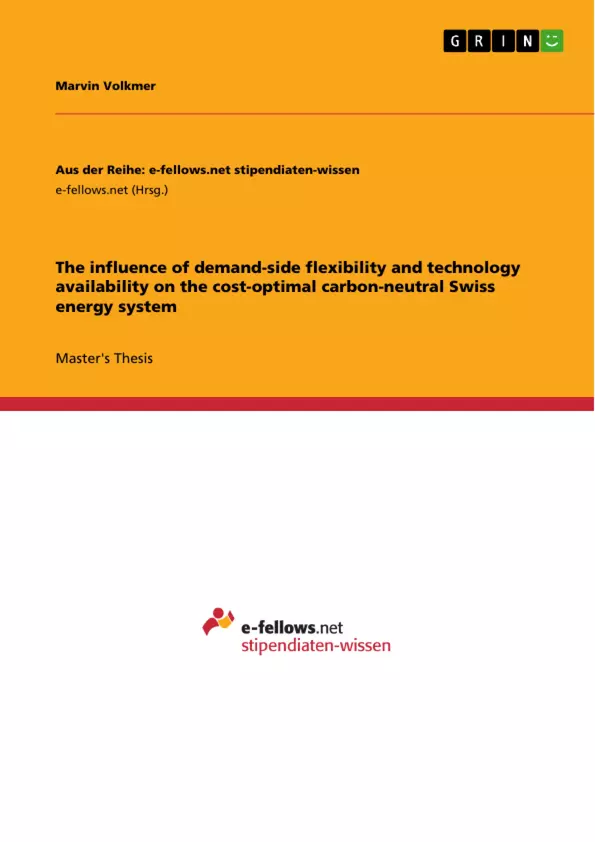In order to mitigate climate change, Switzerland has committed to carbon-neutrality by year 2050, while phasing out its nuclear power plants. Due to the increasing electrification of the Swiss energy system through heat pumps and battery electric vehicles, more renewables have to be installed and integrated into the heat and mobility sector. Besides the installation of storages, a higher degree of energy market integration and demand-side flexibilities seems promising to counteract the deviations between energy supply and demand. However, some measures of potential technologies, demand-side flexibilities, and market integrations are unpopular among the Swiss population, as these measures might intervene people's comfort zones.
It would be helpful for policymakers to have only few measures at hand for which acceptance should be sought among the population. However, finding combinations of few measures among many, leads to an extensive combinatorial problem that we address conducting an energy system optimization. Solving this optimization problem with a large spatially resolved energy system model is desired, yet computationally challenging. Therefore, in this work, we develop two heuristic algorithms, "The Intuitive" and "The Smart". Using a spatially aggregated energy system model, we show that both heuristics result in similar combinations after a few iterations. Besides the development of the heuristic algorithms, we extend the Swiss energy system model, considering biomass-to-energy processes, on-site carbon capture, and flexibility options in the electricity, heat, and mobility sector.
"The Smart" uniquely categorizes measures into the categories technology availability, demand-side flexibility, and market integration, as we assume synergetic effects across categories. The results prove our assumption: Both heuristics terminate with a combination of three measures with one from each category and show that having a high potential of carbon capture and storage in combination with allowing for abroad compensation of CO2 is beneficial.
This study presents insights into implications of various measures on the Swiss energy system, as well as potential synergies, when measures are combined with each other. Furthermore, both heuristic algorithms find suitable solutions for our problem in only few iterations, which is promising with regard to the aforementioned application in large, spatially resolved energy system models.
Inhaltsverzeichnis (Table of Contents)
- 1 Introduction
- 2 Theory
- 2.1 Energy Systems Optimization
- 2.1.1 Mathematical Foundations of Optimization
- 2.1.2 Modeling Framework SecMOD
- 2.1.3 Multi-Objective Optimization
- 2.2 Literature Review on Heuristic Algorithms
- 2.2.1 Trajectory-based Methods
- 2.1 Energy Systems Optimization
- 3 Implementation of Constraints
- 3.1 Technology Availabilities
- 3.1.1 Alpine PV
- 3.1.2 Wind Energy
- 3.1.3 Electrified Residential Heating
- 3.1.4 Carbon Capture and Storage
- 3.1.5 Hydrogen Storages
- 3.2 Demand-side Flexibilities
- 3.2.1 Electricity Demand Flexibility
- 3.2.2 Residential Heat Demand Flexibility
- 3.2.3 Mobility Demand Flexibility
- 3.2.4 Industrial Heat Storages
- 3.3 Market Integration Levels
- 3.3.1 Electricity Market
- 3.3.2 Hydrogen and Synthetic Gas Market
- 3.3.3 CO2 Compensation Abroad
- 3.4 Consideration of Measure Costs
- 3.1 Technology Availabilities
- 4 Heuristic Algorithms
- 4.1 Considered Optimization Problem
- 4.2 Preparation of the Heuristic Algorithms
- 4.2.1 Total Cost Reduction Potential
- 4.2.2 Individual Cost Reduction Potentials
- 4.3 Heuristic Algorithm 1 "The Intuitive"
- 4.4 Heuristic Algorithm 2 – "The Smart"
- 5 Case Study
- 5.1 Swiss Energy System Model
- 5.1.1 Spatial Aggregation
- 5.1.2 Model Setup
- 5.2 Model and Optimization Parametrization
- 5.3 Limited Resource Availabilities
- 5.1 Swiss Energy System Model
- 6 Results and Discussion
- 6.1 Resulting Individual Cost Reduction Potentials
- 6.2 All-Conservative vs. All-Progressive
- 6.2.1 Cost Comparison
- 6.2.2 Utilization of Progressive Technology Availabilities
- 6.2.3 Carbon Balance
- 6.3 Heuristic Algorithms Results
- 6.3.1 "The Intuitive"
- 6.3.2 "The Smart"
- 6.4 Generation of Alternatives
- 6.5 Discussion
- 6.5.1 Interpretation
- 6.5.2 Limitations of our Study
Zielsetzung und Themenschwerpunkte (Objectives and Key Themes)
This master's thesis aims to investigate the influence of demand-side flexibility and technology availability on creating a cost-optimal, carbon-neutral Swiss energy system by 2050, while phasing out nuclear power. It addresses the computational challenges of optimizing a large energy system model by developing and comparing two heuristic algorithms.
- Cost optimization of a carbon-neutral Swiss energy system.
- The role of demand-side flexibility in energy system optimization.
- Evaluation of various technologies for carbon neutrality.
- Development and comparison of heuristic algorithms for energy system optimization.
- Synergistic effects of combining different measures (technology, flexibility, market integration).
Zusammenfassung der Kapitel (Chapter Summaries)
Chapter 1 introduces the context of Switzerland's commitment to carbon neutrality and the challenges involved. Chapter 2 lays the theoretical foundation, covering energy system optimization, the SecMOD modeling framework, and a review of heuristic algorithms. Chapter 3 details the implementation of constraints related to technology availability, demand-side flexibilities, and market integration. Chapters 4 describes the development of two heuristic algorithms, "The Intuitive" and "The Smart". Chapter 5 presents the case study using a spatially aggregated Swiss energy system model. Chapter 6, excluding the conclusion, will discuss the results of the optimization process, analyzing the cost-effectiveness and environmental impact of different strategies.
Schlüsselwörter (Keywords)
Carbon neutrality, Swiss energy system, demand-side flexibility, technology availability, energy system optimization, heuristic algorithms, carbon capture and storage, model SecMOD, cost-optimal.
- Quote paper
- Marvin Volkmer (Author), 2024, The influence of demand-side flexibility and technology availability on the cost-optimal carbon-neutral Swiss energy system, Munich, GRIN Verlag, https://www.grin.com/document/1514014



